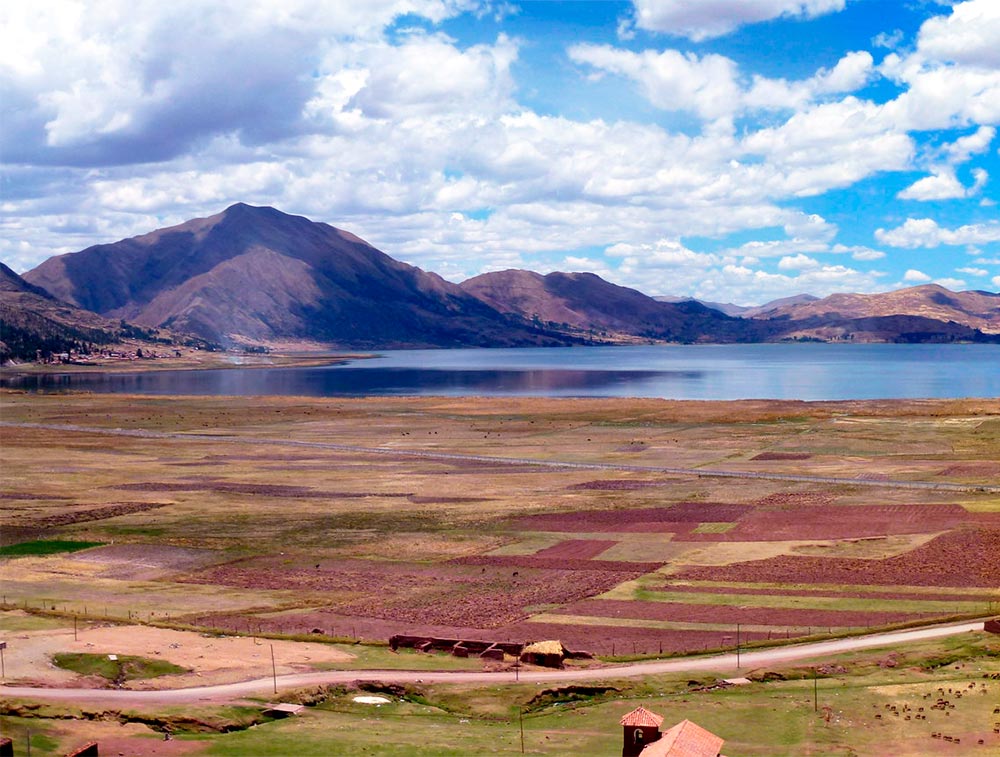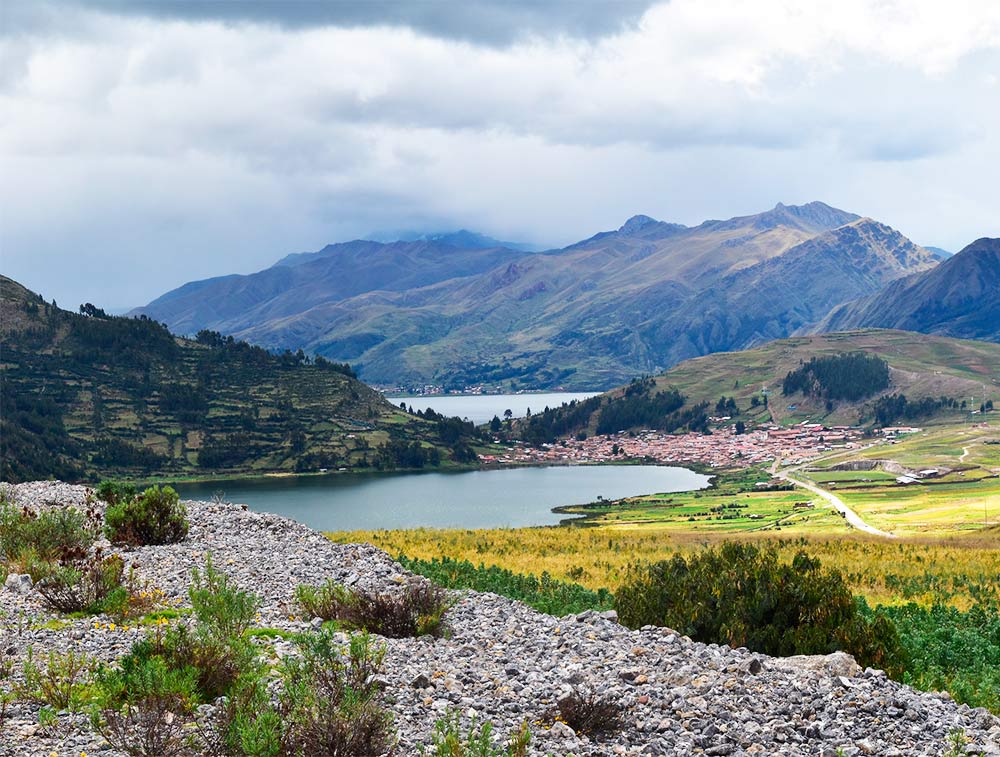Circuit of the 4 lagoons in Cusco
The circuit of the 4 lagoons is a journey through four of the most beautiful natural landscapes of Cusco: the Pomacanchi, Acopia, Asnaqocha and Pampamarca lagoons (also called Tungasuca) . There, in addition to beautiful landscapes, tourists will be able to fish, learn about different types of flora, fauna and visit Andean towns with many history.
- What is it about?
- Where is?
- Map
- How to get there?
- Flora and fauna
- The town of Túpac Amaru II
- Weather
- Photo gallery
- Other nearby attractions
- More information

Circuit 4 lagoons
What is it about?
- For a long time the four lagoons were part of the beautiful Andean landscape of the towns located south of Cusco.
- Due to the boom in tourism in the region (especially due to the arrival of tourists seeking to see Waqrapukara and the Queswachaka bridge); More than 40 local communities made an effort to organize a tourist circuit to four of its most beautiful lagoons: Pomacanchi, Acopia, Asnaqocha and Pampamarca (or Tungasuca).
- Today the ‘Circuit of the 4 lagoons’ is a tour that is gaining more and more popularity in Cusco.
These are the loopholes in the circuit:
- Laguna Pomacanchi : The first lagoon, the largest of all, is called Pomacanchi due to its proximity to the town of the same name. In its blue waters live trout, silverside, carachis and more. The deepest point of the lagoon reaches 140 meters. The riverbanks of the place have camps with food stalls, viewpoints as well as pedal boats. Tours of the lagoon and fishing are allowed.
- Acopia Lagoon – The second lagoon is called Acopia, as the name of the town located on its banks. In its blue waters live birds such as ducks or pelicans. The lagoon is located 3,707 meters above sea level. The town of Acopia is famous for being the home of Valeriana Huillca Condori, better known as Valicha, source of inspiration for composer Miguel Ángel Hurtado for the creation of the Cusco huayno ‘Valicha’, recognized and sung throughout Peru.
- Asnaqocha Lagoon – The third lagoon is Asnacocha. Its name, translated from the Quechua language, means ‘smelly lagoon’. What is the name? In the waters of this lagoon there is a proliferation of algae. When heated with the sun, these algae give off a peculiar smell that fill the environment with that strange smell. The town of Mosoqllacta, which reaches an altitude of 3,800 meters above sea level, is located at the foot of this lagoon. Some visitors who come there on their own choose to camp on the banks of the Asnacocha.
- Laguna Pampamarca – The fourth lagoon in the circuit is called Pampamarca due to its proximity to the Andean town of the same name. Other settlers call it Tungasuca due to its proximity to this other Andean town. The lagoon is home to wild animals such as parihuanas (famous for their red and white plumage), ducks and fish. Due to the abundance of reeds, it is common to see boats made of this material sailing in the waters of the Pampamarca.
Where is it?
- The circuit of the 4 lagoons is located about 98.6 kilometers by road from the city of Cusco. The lagoons are located on the border of the provinces of Acomayo and Canas. The average altitude reaches 3,700 meters above sea level.
Circuit map 4 lagoons
How to get there?
If you visit the circuit of the 4 lagoons with a tour, be careful that tourist transport is already included.
On the other hand, if you come on your own you must make the following routes :
- From Cusco to Cusipata: on Huayruropata avenue there are public transport buses that for 3 or 4 dollars will take you to the town of Cusipata. The trip takes almost 2 hours.
- From Cusipata to Pomacanchi: in the town of Cusipata you can take public transport to the town of Pomacanchi. The journey takes less than 1 hour and can cost between $ 3 to $ 4 per person.
- From Pomacanchi to the lagoons: In Pomacanchi you can hire a private transport (taxi) to visit the four lagoons. The total route is a little over 30 kilometers. The cost of transportation can vary between 15 to 30 dollars, depending on the agreement with the owner of the transportation.
Flora and fauna
During the circuit of the 4 lagoons, the tourist will be able to appreciate different types of species of flora and fauna, such as:
- Wild duck – The scientific name of this bird is Spatula puna. It inhabits lakes and lagoons in the high Andean regions, from 3,100 to 4,600 meters above sea level. Its main characteristic is its black crown on the head.
- Parihuana – The scientific name of this migratory bird is Phoenicoparrus andinus. Its preferred habitat is the Andean region, from southern Peru to northern Chile or Argentina. It also flies to the Pacific coast. It stands out for its pinkish chest and reddish feathers.
- Silverside – The freshwater silverside, whose scientific name is Odontesthes bonariensis, inhabits rivers and lagoons in the Andean regions of Argentina, Uruguay, Chile, Peru and Bolivia. It stands out for its size and flavor. It feeds on algae and smaller fish. They have been introduced to other ecosystems such as Lake Titicaca (Peru).
- Lake algae – Andean lagoon algae are known as the ‘cushuro’. Its scientific name is Nostoc sphaericum. Many Andean communities consume it for its high nutritional value. Although they are not exactly algae (they are cyanobacteria), just like these, they know how to provide their own food through photosynthesis (they receive the sun’s rays).
- Icchu – The scientific name for this wild herb is Stipa ichu. This species is native to the Americas, from Guatemala to Argentina through the Andes Mountains. It is characterized by its grasslands with stems up to 180 centimeters high. It serves as food for cattle and auquénidos. It grows in cold regions over 3,700 meters above sea level.
The town of Túpac Amaru II
- José Gabriel Condorcanqui (1738 – 1781), better known as Túpac Amaru II, was a Peruvian revolutionary who faced the authorities of the Spanish colony in the 18th century.
- This descendant of the Inca lineage led a rebellion, mainly in the cities of the Andes Mountains of Peru, which ended with his execution in the Main square of the city of Cusco.
- It is stated that his rebellion preceded the pro-independence current that would finally achieve its goal of emancipation in 1811.
- José Gabriel Condorcanqui was born in the town of Surimana (Cusco), a short distance from the ‘Circuit of the 4 lagoons’ (on the banks of the Apurímac River). In his adulthood he was curaca of the towns of Tungasuca, Tinta, Surimana and Tinta.
- However, due to harassment by the Spanish authorities, he organized a rebellion that would end with his death by dismemberment in the Main square of Cusco.
- Currently, in his native town of Surimana is the house where Túpac Amaru II was born. This was prepared to receive visitors and show part of the history of this Peruvian hero.
- Likewise, in the town of Tinta there is a house-museum that, through didactic rooms, exposes the importance of this Cusco character. In the Main square of Cusco there is a monument in his honor and that of his relatives executed there in 1781.
Climate
- The weather during the ‘Circuit of the 4 lagoons’ is cold. During the day the temperature can reach 20ºC. At sunset, the towns and lagoons of this Andean region can feel cold as low as 0ºC.
- To combat the cold weather during the circuit, it is recommended to wear a jacket over a sweater. Also, comfortable and thermal pants, preferably.
Other nearby attractions
- Waqrapukara – This archaeological site has enclosures, temples, platforms, squares and more. There are several pre-Hispanic roads that lead there. For this reason it is presumed that it was a religious sanctuary. There is no transport that takes you directly there. It is necessary to take a walk of approximately 2 hours. Waqrapukara has a rock formation similar to that of a castle with two huge horns.
- Bridge Q’eswachaka – In the town of Quehue there is a Q’eswachaka suspension bridge of Inca origin. Every year, through a ceremony that also has its origins in the Incan, the local inhabitants of the communities of Huinchiri, Chaupibanda, Ccollana, Quehue and Pelcaro carry out the renovation works of the bridge made of icchu or Andean straw.
- Colonial Bridge of Chacacupe – This traditional town located 98 kilometers by road from the city of Cusco, has an immense bridge of colonial origin that continues to be used to this day. In addition, a short distance away are an Inca bridge and another one of republican origin that is very old.
More information
- In the case of lagoons, another recommended alternative is the ‘Circuit of the 7 lagoons , in the Ausangate. These are the lagoons: Pucacocha, Patacocha lagoon, Alqacocha lagoon, Qomercocha lagoon, Orco otorongo lagoon, Chinese otorongo lagoon and Cocha blue lagoon. They stand out for the beauty of their landscape located at the foot of the immense Ausangate snow-capped mountain.
- The Circuit of the 4 lagoons is organized by the Andean communities that live in the surroundings. Most of them have viewpoints, rafts, restaurants and toilets.
- The best time to do this circuit is during the dry season, that is, in the months from April to October. The rest of the year, the rains are more frequent which can make the trip difficult. Even so, there are visitors who dare to go at any time of the year.
By Ticket Machu Picchu – Last updated, August 15, 2024












